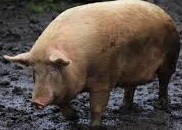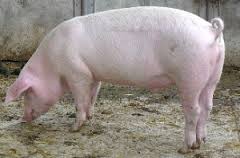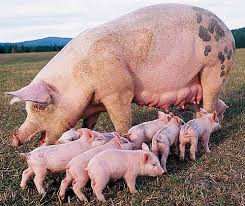
Large white pig
(Sus scrofa domesticus)

The domestic pig, often called swine, hog, or pig when there is no need to distinguish it from other pigs, is a large, even-toed ungulate. It is variously considered a subspecies of the wild boar or a distinct species. The domestic pig's head-plus-body-length ranges from 0.9 to 1.8 m (35 to 71 in), and the adult can weigh between 50 to 350 kg (110 to 770 lb). Compared to other artiodactyls, its head is relatively long, pointed, and free of warts. Even-toed ungulates are generally herbivorous, but the domestic pig is an omnivore, like its wild relative.
Domestic pigs are farmed primarily for the consumption of their meat called pork. The animal's bones, hide, and bristles are also used in commercial products. Domestic pigs, especially the pot-bellied pig, are sometimes kept as pets.
Conservation status
Domesticated
Scientific classification |
|
| Kingdom: | Animalia |
| Phylum: | Chordata |
| Class: | Mammalia |
| Order: | Artiodactyla |
| Family: | Suidae |
| Genus: | Sus |
| Specie: | Sus scrofa domesticus |
Description

The domestic pig typically has a large head, with a long snout which is strengthened by a special prenasal bone and a disk of cartilage at the tip. The snout is used to dig into the soil to find food, and is a very acute sense organ.
There are four hoofed toes on each foot, or trotter, with the two larger central toes bearing most of the weight, but the outer two also being used in soft ground.
Most domestic pigs have rather a sparse hair covering on their skin, although woolly-coated breeds, such as the Mangalitsa, are raised.
Pigs possess both apocrine and eccrine sweat glands, although the latter appear limited to the snout and dorsonasal areas. Pigs, however, like other "hairless" mammals (e.g. elephants, rhinos, and mole-rats), do not use thermal sweat glands in cooling. Pigs are also less able than many other mammals to dissipate heat from wet mucous membranes in the mouth through panting. Their thermoneutral zone is 16 to 22 °C. At higher temperatures, pigs lose heat by wallowing in mud or water; although it has been suggested that wallowing may serve other functions, such as protection from sunburn, ecto-parasite control, and scent-marking.
Pigs are one of four known mammalian species which possess mutations in the nicotinic acetylcholine receptor that protect against snake venom. Mongooses, honey badgers, hedgehogs, and pigs all have modifications to the receptor pocket which prevents the snake venom α-neurotoxin from binding. These represent four separate, independent mutations.
Female hogs reach sexual maturity at 3-12 months of age and come into estrus every 18-24 days if they are not successfully bred. The gestation period averages 112-120 days.
Behavior

The behaviour of domestic pigs resembles that of dogs and humans more than that of cattle or sheep. In many ways, their behaviour appears to be intermediate between that of carnivores and artiodactyls. Domestic pigs seek out the company of other pigs, and often huddle to maintain physical contact, although they do not naturally form large herds. They typically live in groups of about 8-10 adult sows, some young individuals, and some single males.
Because of their relative lack of sweat glands, pigs often control their body temperature using behavioural thermoregulation. Wallowing, which often consists of coating the body with mud, is a behaviour frequently exhibited by pigs. Pigs root to make wallows that sometimes contains sticky mud with which the pigs cover their body. Pigs do not submerge completely under the mud, but vary the depth and duration of wallowing depending on environmental conditions. Typically, adult pigs start wallowing once the ambient temperature is around 17-21°C. On hot days, pigs cover themselves from head to toe in mud. Pigs may also use mud as a sunscreen, protecting their skin from ultraviolet light, or as a method of keeping parasites away.
If conditions permit, domesticated pigs feed continuously for many hours and then sleep for many hours, in contrast to ruminants which tend to feed for a short time and then sleep for a short time. Pigs are omnivores and are highly versatile in their feeding behaviour. They can survive well by scavenging on the same types of foods that humans and dogs can live on. In the wild, they are foraging animals, primarily eating leaves, grasses, roots, fruits and flowers. Domestic pigs are intelligent and can be trained to perform numerous tasks and tricks.
Zoológico de Vallarta A. C.
Leave your comments, your opinion is important to us

